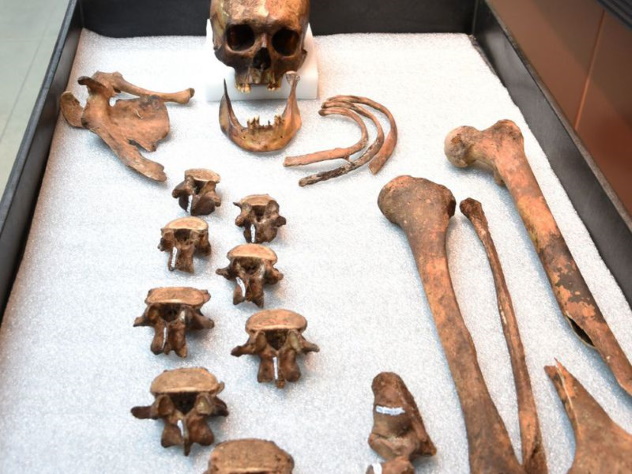10An Unlikely Pregnancy
Photo credit: EurohoopsA male basketball player was caught trying to cheat a doping test after the results showed that he was pregnant.Donell “D.J.” Cooper entered the 2013 NBA draft. He went unsigned and, instead, played for various European basketball teams. In 2018, he tried to join the Bosnian national team as a naturalized player. He didn’t make the cut and also did not play with any other team the whole year.Now we know why: FIBA had suspended him two years for fraud. A drug test revealed the presence of human chorionic gonadotropin or hCG. However, this is not a performance-enhancing drug but rather a hormone created by the placenta during pregnancy. Since there was a pretty decent chance that Cooper was not, in fact, pregnant, this meant that he tried to pass off someone else’s urine as his own. Reportedly, it belonged to his girlfriend.[1]
9For Sale: Volcano
Photo credit: Jackson-StopsIf you are an aspiring supervillain on a tight budget, you probably can’t afford a skull-shaped island for your secret lair. Fortunately, now you can buy the next best thing for a reasonable £50,000 ($61,000)—a 250-million-year-old inactive volcano.[2]Located in Devon, England, the ancient geological feature sits next to a tiny settlement called Posbury. Despite its diminutive size, the community has been occupied since the Iron Age and had long contained a quarry which mined basalt stone. The volcano itself is known as the Posbury Clump because it rests underneath a thick woodland.The area has also been designated a Site of Special Scientific Interest because you can still find signs of potassium-rich lava dating all the way back to the Permian Period, when dinosaurs were just starting to appear on this planet.
8Terrifyingly Thunderous Toilet Trouble
Photo credit: KTRK-TVThere was a “first in plumbing history” as lightning hit a house’s septic tank, causing the toilet to explode.Early Sunday morning, Marylou Ward and her husband were still in bed in their Port Charlotte, Florida, home when they felt the house rocked by a loud explosion. They were shocked to discover that the toilet in their master bathroom blew up. The force was powerful enough to shatter it completely and send pieces of porcelain flying with enough strength to penetrate the wall.When the Wards brought in a plumber to assess the damage, he said that neither he nor his father had ever seen anything like it despite decades of experience. Besides the toilet, the sanitary pipe and the lid of the septic tank had both disintegrated.The cause of the explosion was a buildup of methane gas in the septic tank.[3] Once it got hit by lightning, it ignited with a powerful blast. Jordan Hagadorn, the plumber who inspected the wreckage, said that the tank lid was only buried 2.5 centimeters (1 in) underground, which could have helped facilitate the explosion.
7Hercules The Parrot
Photo credit: Dr. Brian Choo/Flinders UniversityPrehistoric times were filled with giant versions of animals that are still around today. Now, there is a new one to add to the list: Heracles inexpectatus, the Hercules parrot.The large bird was described for the first time a few days ago in Biology Letters from fossils found over a decade ago in St Bathans, Otago, New Zealand. They are roughly 19 million years old and once belonged to a parrot that stood 1 meter (3’3″) tall and weighed up to seven kilograms (15 lb).[4]By comparison, the kakapo, the largest extant parrot species, rarely exceeds half that amount. In fact, researchers believe the two might be related, both part of the Nestoridae family, or the New Zealand parrot, as it’s better known.Gigantism is a common trait in New Zealand’s bird population, one that likely arose from a lack of competition from mammals or reptiles. However, it has never been seen before in parrots.
6The Identity Of The New England Vampire
Photo credit: Defense Visual Information Distribution ServiceBack in the 19th century, rural New England succumbed to a vampire panic. Entire families were being ravaged by tuberculosis, but they ascribed the plague to their departed love ones, who were coming back from the dead. To counter this affliction, people dug up the bodies of the dead and performed various rites on them. Most common was burning the heart.Most of these events were done in private, although there were a few cases, like that of Mercy Brown, where the entire village took part. Out of dozens of documented cases, only one left physical evidence for modern archaeologists. Back in 1990, boys stumbled upon the remains of a “vampire” in Griswold, Connecticut, and now, researchers believe they have identified him.On the coffin, tacks were used to spell out “JB 55,” most likely the deceased’s initials and age. Inside where the remains of a middle-aged man, most likely a farmer or laborer based on the arthritis in his bones, who, indeed, suffered from tuberculosis. He had also clearly been the target of an anti-vampire ritual. His skull had been severed from the spine and placed on the chest alongside his femurs to form a skull and crossbones. His body had also been dug up after burial, and his heart had been removed and, most likely, incinerated.[5]Researchers used modern forensics to analyze the remains but also dug through old records. They found an obituary from 1826 for a young boy called Nicholas Barber which also made mention of his deceased father, a farmer named John Barber, whose initials and age estimate match the markings on the coffin. Moreover, next to the grave was another coffin with tacks spelling out “NB 13,” likely that of Nicholas.Scientists are pretty confident that John Barber was the New England vampire, although they don’t know what he did to earn that reputation other than dying of tuberculosis.
5Atomik Vodka
Photo credit: BBC NewsBartenders from Bar Swift in fashionable Soho, London, made the first-ever Atomik martini. It is one of the rarest drinks on the planet because only one bottle of the vodka used to make it exists. Also called Atomik, the spirit was made using water and grain from Chernobyl.The “artisan vodka” is the work of a team of British scientists from the University of Portsmouth. First, they grew rye grain on a farm located...


















